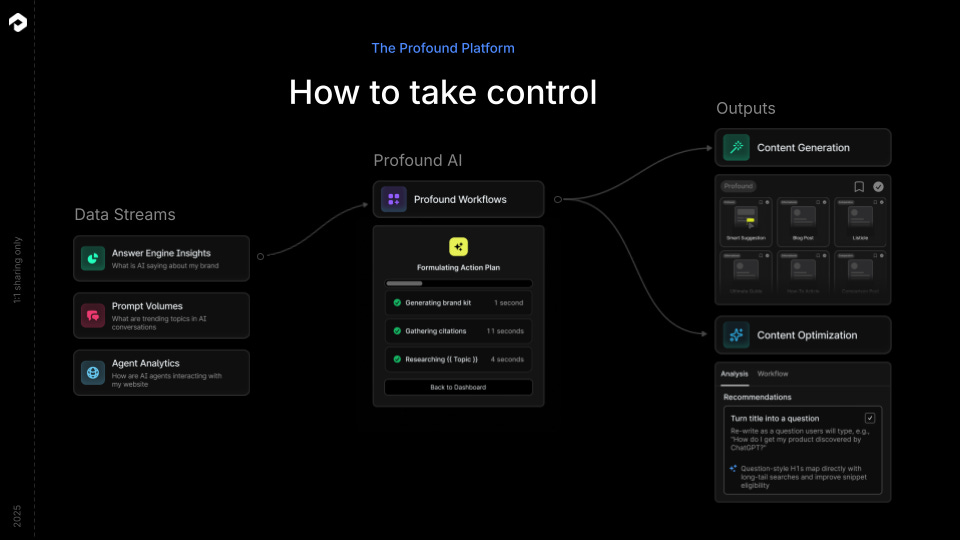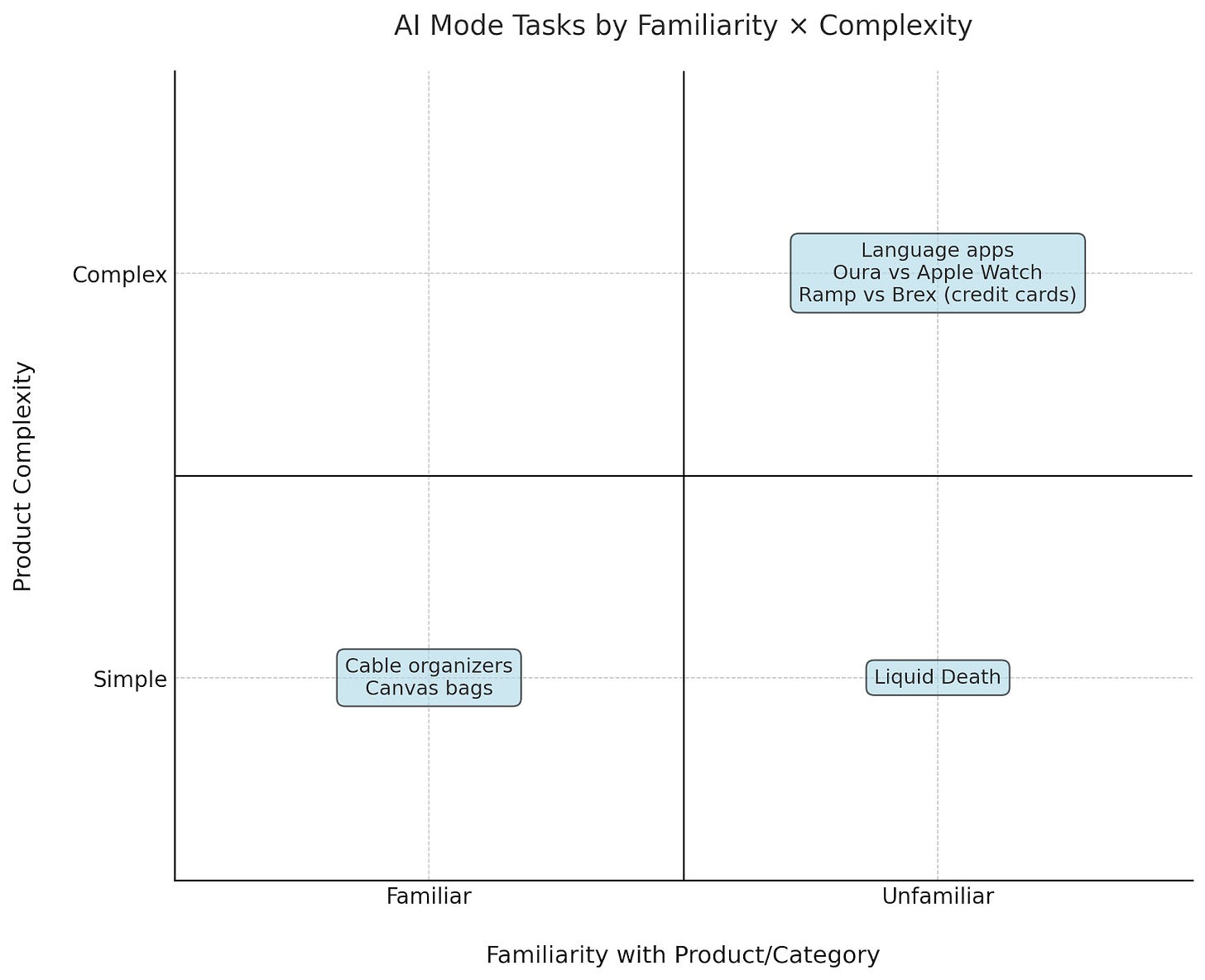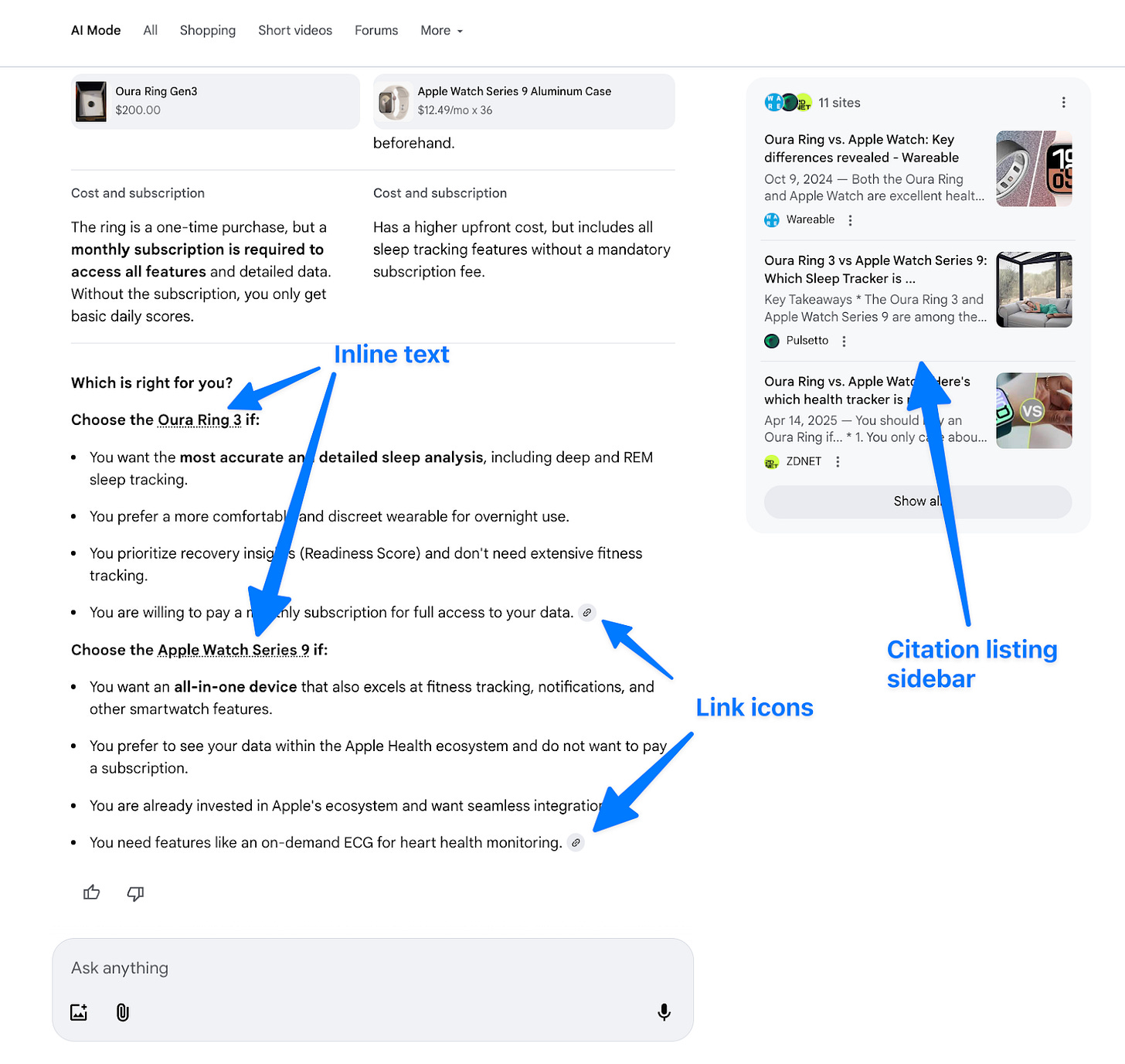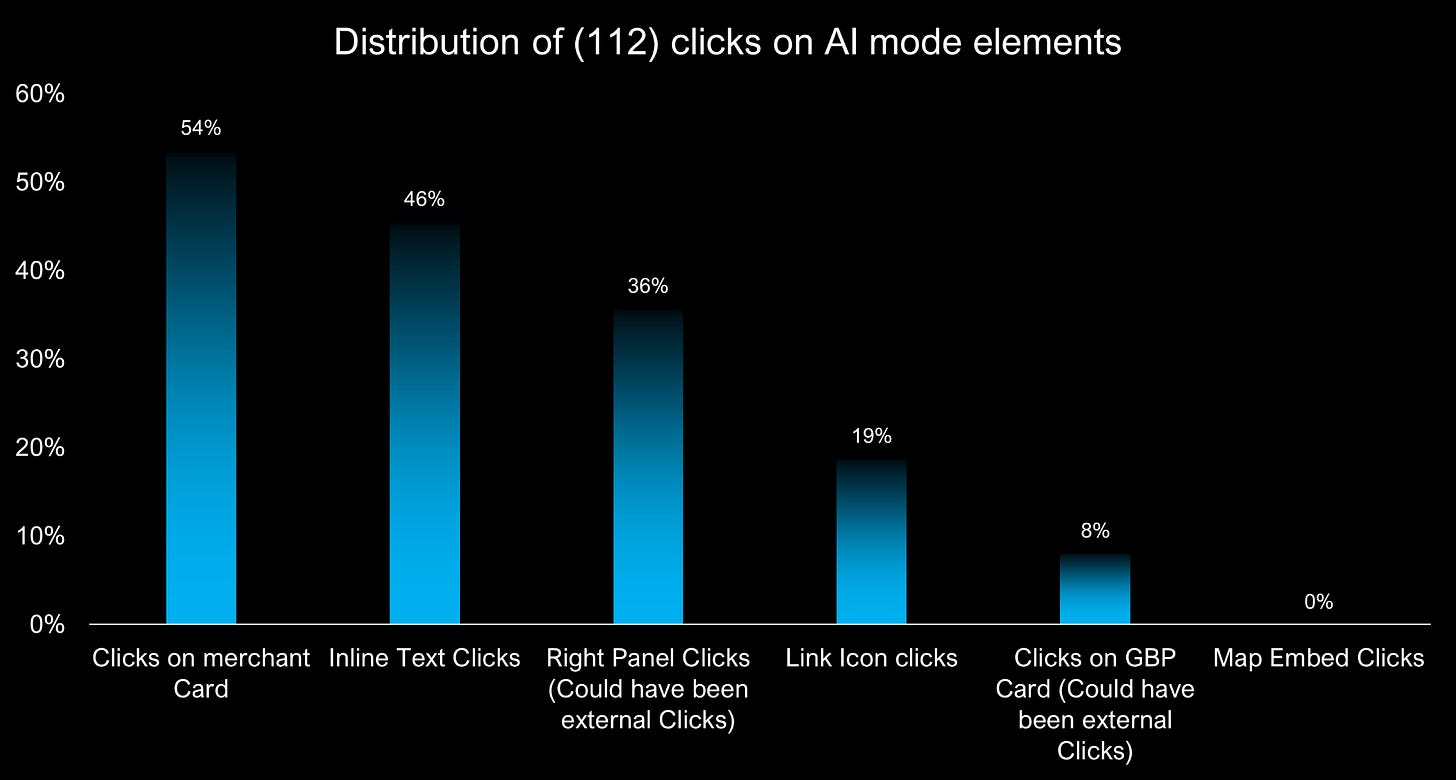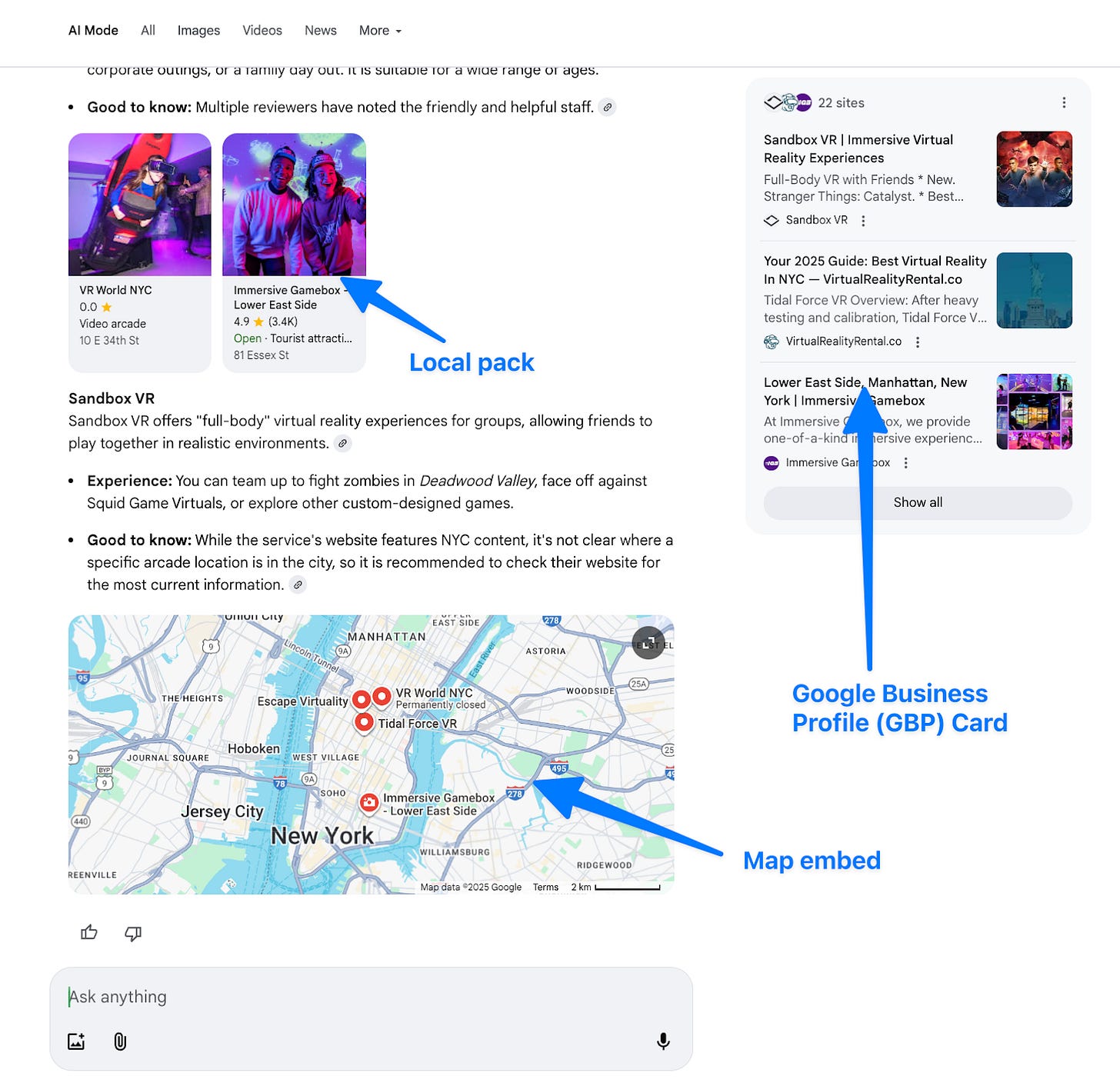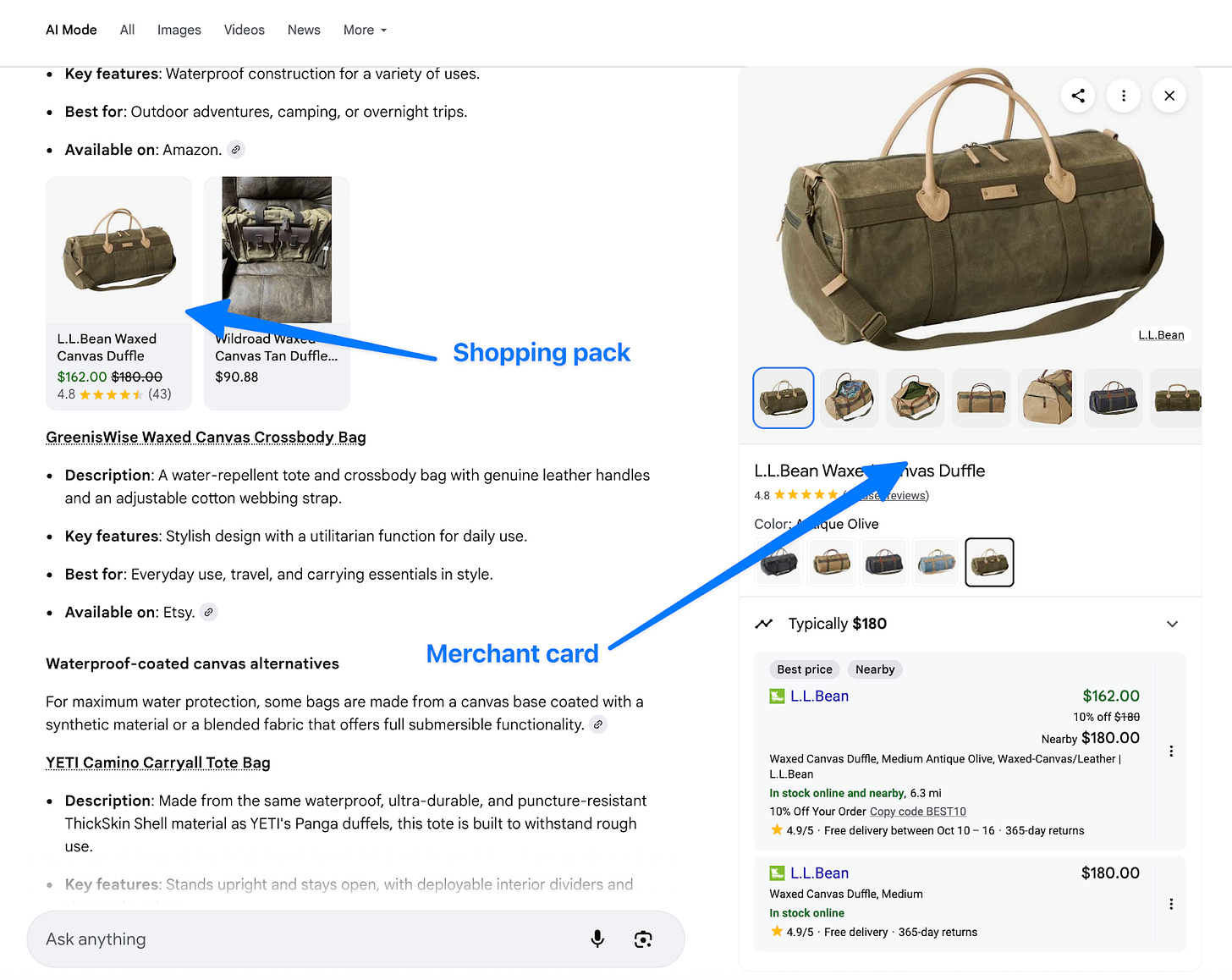Google’s AI Mode SEO Impact | AI Mode User Behavior Study Part 2
This week, I’m covering what’s measurable, what’s guesswork, and what’s possibly next for visibility, trust, and monetization in AI Mode.
This Memo was sent to 22,174 subscribers. Welcome to +136 new readers! You’re reading the free version of Growth Memo. Premium subscribers get deeper strategy breakdowns, original research, and exclusive content drops - including today’s stakeholder slide deck template, so you can quickly communicate these findings and changes in meetings.
A few more conferences I speak at over the next weeks (hope to see you there!):
Last week, I shared the largest usability study of AI Mode, and it revealed how users interact with the new search surface:
They focus on the AI Mode text first 88% of the time, ignore link icons, and rarely click out.
This week, for Part 2, I’m covering what’s measurable, what’s guesswork, and what’s possibly next for visibility, trust, and monetization in AI Mode.
If you have questions about the study methodology or initial findings, make sure to check out What Our AI Mode User Behavior Study Reveals about the Future of Search to get up to speed.
Because this week, we’re jumping right in.
Using the largest dataset on AI visibility in the world, Profound helps brands create highly researched, accurate, and pre-optimized content that LLMs love.
Generate content that matches your brand voice, product information and guidelines without manual oversight.
Which AI Mode elements can you “optimize” for?
Before we dive into additional findings that I didn’t have room to cover last week, first, we need to get on the same page about your brand’s visibility opportunities in AI Mode.
There are a few distinct visibility opportunities, each with different functions:
Inline text links or inline links: A hyperlink directly in the AI Mode output copy that opens a feature in the right side panel for user exploration; extremely rarely, an AI Mode inline text link may open an external page in a new tab.
Link icons: Grey link icon that displays citations in the right sidebar.
Citation listings side panel/sidebar: List of external links (with an image thumbnail) the AI Mode is sourcing from; appears in the right column. The link icon “shuffles” this list when clicked.
Shopping packs: These appear similar to shopping carousels within classic organic search, and they occur in the left panel within the AI Mode text output.
Local packs: These are similar to the local packs paired with the embedded map within classic organic search, and they occur in the left panel within the AI Mode text output (very similar to the Shopping packs above).
Merchant card: Once a selection is made in the shopping pack, it opens a merchant card for further inspection.
Google Business Profile (GBP) Card: This appears on the right when a merchant card from a local pack is clicked. Once clicked, the GBP Card opens for further inspection.
Map embed: Embedded local map displaying solutions to the prompt/search need in the area.
Our AI Mode usability study collected data from 37 participants across 7 specific search tasks, resulting in 250 unique tasks that provided robust insight on how people navigate the different elements within AI Mode.
The data showed that some of these visibility opportunities are more valuable than others, and it might not be the ones you think.
Let me level with you: I will not pretend I have the answers to exactly how you can earn appearance in each of the above AI Mode visibility opportunities (yet - I’m studying this intently as AI Mode rolls out globally across my clients and user adoption increases).
I would argue that none of us have enough data - at least, as of right now - to give exact plays and tactics to earn reliable, recurring visibility in new AI-chat based search systems.
But what I can tell you is that high-quality, holistic SEO and brand authority practices have influence on AIO and AI Mode visibility outcomes.
Brand trust is the #1 influence factor in AI Mode
If it feels like I keep saying this repeatedly over the past few months - that brand trust and authority matter more than ever in AI Mode and AI Overviews - it’s because it’s true and underrated.
Similar to the UX study of AI Overviews I published in May 2025, the AI Mode study I published last week also confirms:
If AI Mode is a game of influence, then trust has the biggest impact on user decisions.
Your goal is to ensure your brand is (1) trusted by your target audience and (2) visible in AI Mode output text.
I’ll explain.
Study participants took on the following 7 tasks:
What do people say about Liquid Death, the beverage company? Do their drinks appeal to you?
Imagine you’re going to buy a sleep tracker and the only two available are the Oura Ring 3 or the Apple Watch 9. Which would you choose, and why?
You’re getting insights about the perks of a Ramp credit card vs. a Brex Card for small businesses. Which one seems better? What would make a business switch from another card: fee detail, eligibility fine print, or rewards?
In the “Ask Anything” box in AI Mode, enter “Help me purchase a waterproof canvas bag.” Select one that best fits your needs and you would buy (for example, a camera bag, tote bag, duffel bag, etc.).
Proceed to the seller’s page. Click to add to the shopping cart and complete this task without going further.
Compare subscription language apps to free language apps. Would you pay, and in what situation? Which product would you choose?
Suppose you are visiting a friend in a large city and want to go to either: 1. A virtual reality arcade OR 2. A smart home showroom. What’s the name of the city you’re visiting?
Suppose you work at a small desk and your cables are a mess. In the “Ask anything” box in AI Mode, enter: “The device cables are cluttering up my desk space. What can I buy today to help?” Then choose the one product you think would be the best solution. Put it in the shopping cart on the external website and end this task.
Look at these quotes from users as they made shopping decisions:
“If I were to choose one, I would probably just choose Duolingo just because I’ve used it. … I’m not too certain about the others.”
“Okay, we’re going with REI, that’s a good brand.”
“I don’t know the brand … that’s why I’m hesitant.”
“I trust Rosetta Stone more.”
Unless we’re talking about utility goods (like cables), where users decide by price and availability, brand makes a huge difference.
Participants’ reactions were strongly shaped by how familiar they were with the product and how complex it seemed.
With simple, familiar items like cable organizers or canvas bags, people could lean on prior knowledge and make choices confidently, even when AI Mode wasn’t perfectly clear.
But with less familiar or more abstract categories - like Liquid Death, language apps, or Ramp vs. Brex - user hesitation spiked, and participants often defaulted to a brand they already recognized.
Our AI Mode usability study showed that when brand familiarity is absent, shoppers default to marketplaces - or they keep reading the output.
Speaking of continuing reading through the AI Mode output, the overwhelming majority of tasks (221 out of 248, ~89%) show AI Mode text as the first thing participants noticed and engaged with.
This cannot be stressed enough.
It suggests the AI Mode output text itself is by far the most attention-grabbing entry point, ahead of any visual elements.
Inline text links beat link icons
Recently, VP Product Search at Google, Robby Stein, said on X:
“We’ve found that people really prefer and are more likely to click links that are embedded within AI Mode responses, when they have more context on what they’re clicking and where they want to dig deeper.”
We can validate why Google made this choice with data.
But before you dive in below, here’s some additional context:
The inline text links are what we call the actual URL hyperlinks within the AI Mode copy, which is what Robby Stein is referring to above in his quote)
The grey link icon users hover over is what we call (in this study) the link icon
The rich snippet on the right side of AI mode is what we refer to as the side panel or sidebar
We found that inline text links draw about 27% more clicks than the right side panel of citations.
Inline links are within the copy or claim users are trying to verify, while the link icons feel detached and demand a context switch of sorts. People aren’t used to clicking on icons vs. text or a button for navigation.
This is notable because if Google were to adopt inline links as the default, it could raise the number of click-outs in AI Mode.
The biggest takeaway from this?
Getting a citation/inclusion within a link icon isn’t as valuable as an inline text link in the body of AI Mode.
It’s important to mention this, because many SEOs/marketers could assume that getting some kind of visibility within the link icon citations is valuable for our brands or clients.
Of course, I’d argue that any hard-won organic visibility is worth something in this era of search. But this usability study indicates that inclusion in a link icon citation likely has no real impact on visitors. So correcting this assumption amongst our industry - and our clients - is wise to do.
Local Packs, Maps, and GBP cards need more data
Another interesting find?
Only 9.6% of valid tasks performed by study participants showed a Local Pack, and the Google Business Profile (GBP) card was effectively absent in nearly all test scenarios.
Only 3% of search tasks for the study showed a GBP card presence in any form.
Most notably: Though not always present, GBP cards played a curious and important role in driving on-SERP engagement. Users tended to scan them quickly, but also click them often.
Their presence appears to compete effectively with external links and merchant cards, which were used much less in the same contexts.
While the user behavior observed here is valid and notable enough for sharing, we must acknowledge that only one search task in the study had a specific localized or geographical intent.
More data is needed to solidify behavioral patterns across search tasks with geographical intent, and SEOs can also take into account that well-optimized GBP cards would be incredibly valuable based on high engagement with that feature.
E-commerce SEOs rest easy: Shopping tasks take the external clicks
In last week’s memo, I highlighted the following:
Clicks are rare and mostly transactional. The median number of external clicks per task was zero. Yep. You read that right. Ze-ro. And 77.6% of sessions had zero external visits.
Here, I’m going to expand on that finding. It’s more nuanced than “users rarely click at all.”
External clicks depend on transactional vs non-transactional tasks. And when the search task was shopping related, the chance of an external click was 100%.
Shopping Packs appeared in 26% of tasks within this study. When they did appear, as in the screenshot, 34 of 65 times it was clicked.
Keep in mind, study participants were directed to take all steps to move through a shopping selection, including making a decision on an item and adding it to cart - just like a high-purchase-intent user would outside of the study environment.
However, when the search task was informational and non-transactional, the number of external clicks to sources outside the AI Mode output was nearly zero across all tasks in this study.
There were common sequences to user behavior when the search task was shopping related:
Shopping Pack clicked → Merchant Card popup opened (occurance: 28 times)
Inline Text Link clicked → Merchant Card popup opened (occurrence: 17 times)
Right panel clicked only (occurance: 15 times)
Shopping packs are popular elements that people click when they want to buy. Remember, clicking on one item or product in a pack brings up the detailed view of that one item (a Merchant Card).
One logical reason? They have images (common UX wisdom says people click where there’s an image).
Questions are the new search habit - and reveal an interesting behavior pattern
It’s no mystery that users have been increasing conversational search since the advent of ChatGPT & Co.
This AI Mode study verified this once again, but the data also surfaced an interesting finding.
Out of 250 tasks, 88.8% of the prompts were framed as AI chatbot queries, or conversational prompts, while 11.2% resembled search-style queries, like classic search keywords. However, it’s important to note that we only analyzed the first initial query of the user and not subsequent followups.
This data validation means users are overwhelmingly leaning toward conversational (chat bot-like) interactions rather than “search-like” phrasing of the past.
But here’s the unusual pattern we spotted in the data:
Users who phrased queries conversationally were much more likely to click out to external websites.
This is interesting because this behavior pattern may also mean “experienced” AI-based search or AI chat users click more to validate or explore information.
This is one hypothesis of why this pattern occurs. Another idea?
If a user takes the time to write a question, they are more careful in their approach to finding information, and therefore, they also want to look outside the “walled garden” of AI mode. This behavior could influence any search personas you develop for your brand.
Our data did not point to an entirely clear reason why the longer conversational phrasing was correlated to a higher likelihood of external website clicks, but it’s noteworthy nonetheless.
🎁 Bonus resource: Stakeholder slide deck template & open questions
You’ll find some open questions and my answer below.
But, the hardest part isn’t seeing the change coming - it’s getting your stakeholders or team to feel the urgency to adapt before AI Mode rewires how people search (and before your brand misses out).
I’ve prepped a slide deck for Growth Premium subscribers to help you:
Present these changes (validated by the study) to leadership or clients
Communicate expected traffic shifts with context
Shift reporting from CTR to visibility and authority





